Last week a co-worker and I attended the National Digital Newspaper Project Awardee Conference in DC. One of our fellow NDNP awardees from Arizona wrote about her experiences at the conference.
Category Archives: Indiana Historic Newspaper Digitization
“Indiana history is the product of local events, and local events tend to be captured within the pages of the community newspapers. The Indiana State Library has worked tirelessly to provide Hoosiers with free access to this information, traditionally on microfilm. Digitization of these newspapers is the ‘next step’ in providing 21st century access for Hoosiers to local events in Indiana history.”
The First African-American Newspaper in Indianapolis Digitized
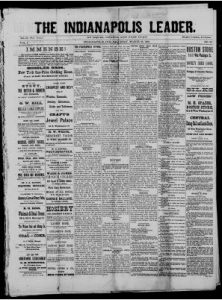
The Indianapolis Leader began in August 1879 as the city’s first black newspaper. Three brothers, Benjamin, Robert, and James Bagby published the four-page, Republican oriented weekly with the motto “An Equal Chance and Fair Play.” The Bagbys advertised the paper as follows: “Let every colored man who favors the elevation of his race subscribe for the Leader; and let every white man who believes that slavery was a crime against humanity and that it is the duty of the ruling race to aid the Negro in his struggle for moral, social and intellectual elevation do likewise.” A correspondent to the Leader wrote, “The interchange of ideas and opinions so judiciously fostered by the Leader is most beneficial to the race in every way….It is a great educator.” The Leader encouraged northern migration for southern African Americans, and carried society news for Indianapolis’s African-American community. The Leader’s reported circulation in 1884 was 3,000. Two other African-American newspapers debuted around this time, the Indianapolis Freeman (1884) and the Indianapolis Colored World (1883).
The Bagby’s sold the Leader in 1885, and its transition at that point is unclear although it ceased to be an African-American newspaper. By 1886, Edward Hutchins was editing and publishing the Leader as a four-page, Greenback affiliated weekly. Vermillion County farmers Andrew J. and Lewis H. Johnson acquired it the next year, before Thomas J. Sharp took over as editor and publisher in 1888. Sharp advertised the Leader as “The great Union Labor paper of Indiana….It circulates…chiefly among farmers and the laboring people.” Sharp reported a circulation of 3,200 in 1888, but the figures fell to 2,300 by 1890. The falling readership perhaps prompted Sharp to sell the paper to John Medert in 1890. Sharp returned as editor in 1891, but the Leader ceased publication sometime that year.
A history of the Jasper Weekly Courier
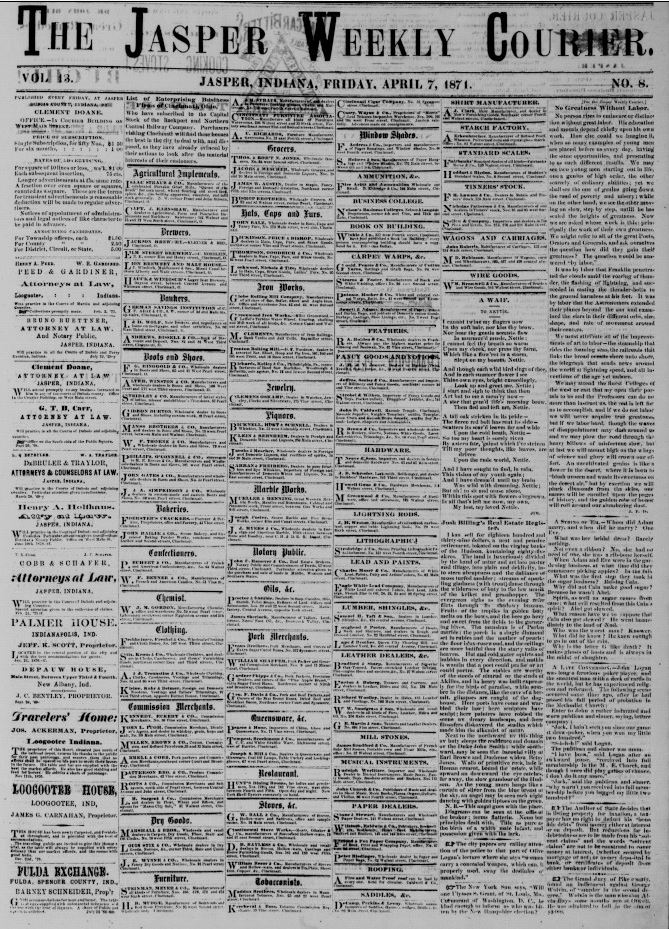
The Jasper Weekly Courier debuted on March 19, 1858 in Jasper, Indiana. Jasper, the county seat of Dubois County in southern Indiana,was an agricultural trade center near iron and coal deposits. John Mehringer, Rudolphus Smith, and Clement Doane published the Courier as an organ of the Democratic Party. The Courier was the first newspaper published in the county since the American Eagle left Jasper in 1848 after a two year publication run. On November 1, 1859, Doane became sole proprietor of the Courier. The paper endorsed Stephen A. Douglas in the 1860 presidential election. The Courier drew criticism early in the Civil War for being disunionist. Doane fired back with an editorial affirming his loyalty, but lamented “a Union which requires bayonets and bullets to keep it together.” In 1872, Doane expanded the four page [five column] weekly to eight pages [also five columns]. He continued to publish the newspaper until his death in 1904. His son, Benjamin E., assumed publishing duties until his death in 1922. Benjamin Doane’s children briefly tried to maintain the Courier, but the newspaper’s publication ceased in July 1922.
For most of its sixty-four year existence, the Courier was the oldest, continuously published, English language newspaper in Dubois County. Jasper’s population ranged from 1,000 to 2,000 during the Courier’s lifetime, and the newspaper’s reported circulation ranged from 350 in 1869 to 750 in 1920. Since the county had a large German speaking population, the very first issue of the Courier bore an advertisement in German announcing, “Advertisements in German will always be handled in this office in the best and cheapest manner.” In 1867, a German language newspaper, the Signal, premeried in nearby Huntingburg to better serve German speaking residents of the county, and eventually boasted a larger circulation than any other nineteenth-century Dubois County newspaper. The Courier’s first viable English language competitor, the Jasper Times, debuted in 1879 as a Democratic organ. The Times converted to a Republican newspaper in 1883, and by 1890 reportedly out-circulated the Courier, 700 issues to 572. Despite this success the Times folded in 1891. Four years later in 1895, the Jasper Herald premiered. The Herald was also a Democratic voice, and eventually superseded the Courier with circulations over 1,000 in the 1910s.
A Brief History of the Indianapolis Journal
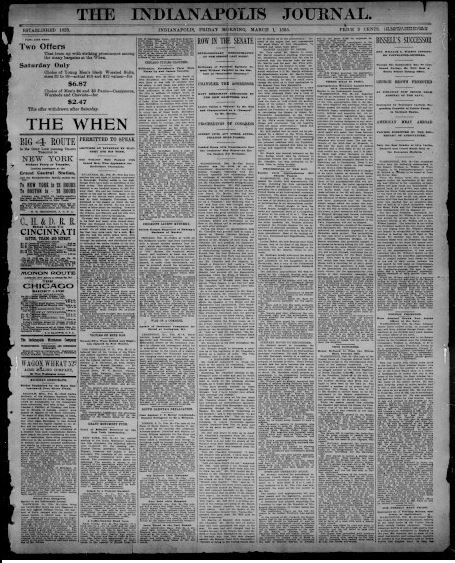
Access 32 years of the Indianapolis Journal (1872-04)!
In 1825, Indiana state printer John Douglass relocated with the state capital from Corydon to Indianapolis, then a town with less than 1,000 residents. Douglass had previously published the short-lived Madison (IN) Western Clarion, and upon arriving in Indianapolis purchased a share of the Western Censor and Emigrants Guide. Douglass and his partner, Douglass Maguire, changed the name to the Indiana Journal, and produced their first issue on January 11, 1825. The anti-Jacksonian publishers advocated for government sponsored internal improvements and protective tariffs that would aid Indiana’s agricultural economy. These political positions led the Journal to align with the emerging Whig Party in the 1830s.
Beginning in 1839 the publishers increased and varied the Journal’s publication frequency based upon when the Indiana General Assembly convened; what had hitherto been a weekly edition, became semi-weekly, tri-weekly, and daily at different times from 1839-1851 to accommodate more state legislative news. In 1840, Douglass and his new partner, Samuel V. B. Noel, also issued a campaign newspaper, the Spirit of ’76, which supported former Indiana Territorial Governor William Henry Harrison’s Whig candidacy for President of the United States. After eighteen years operating the Journal, Douglass sold his interest to Noel in 1843. Noel only maintained sole ownership of the paper for two years, but during that time he changed the name of the paper to the Indiana State Journal, and he allowed Henry Ward Beecher to edit and issue the Indiana Farmer from the Journal’s presses.
John D. Defrees, former publisher of the Northwestern Pioneer and St. Joseph Intelligencer in South Bend, acquired the Journal in 1845 and operated it until 1854. Defrees continued the Journal as a Whig organ, and the paper’s editorials criticizing the Democratic administration’s conduct of the Mexican-American War echoed Whig rhetoric heard around the country. Defrees’s use of the Journal to spread Whig ideas made him an important Indiana political voice, and when the Whig Party collapsed in the early 1850s Defrees became an important leader in the fusionist movement that established the Republican Party in Indiana. Defrees also made several important changes to the Journal and Indiana journalism. He installed the city’s first steam driven printing press, expanded the page format from four to six columns, and introduced better quality illustrations. Defrees also conducted a fierce rivalry with the Democratic Indiana State Sentinel, and introduced Indianapolis’s first permanent daily, the Daily Indiana State Journal, one week before the Sentinel’s daily premiered in April 1851. The daily edition’s title changed to Indianapolis Morning Journal in 1853, the Indianapolis Daily Journal in 1854, and simply the Indianapolis Journal in 1867. The fledgling Indianapolis Locomotive, the brain-child of some Journal apprentices in 1845, demonstrated the reading public’s appetite for more local and society news. The Journal’s daily production schedule created room for local stories, and next day reporting.
One of the most important nineteenth-century Indiana journalists, Berry R. Sulgrove, joined the Journal in 1854 as editor. Sulgrove also wrote much local news copy. He acquired controlling interest in the Journal by 1856, and transitioned the Journal from Whig into the Republican camp. During the Civil War, Sulgrove penned strong Unionist editorials that supported the policies of President Abraham Lincoln and Governor Oliver P. Morton. During the war, the Journal’s daily circulation reached 6,000; for comparison the city’s pre-war population was 18,611.
Indiana had a bustling literary scene in the late 1800s, which was due in part to the Journal’s managing editor Elijah W. Halford’s advocacy and support of Hoosier authors. James Whitcomb Riley, the “Hoosier Poet,” greatly benefitted from Halford’s patronage. Riley published hundreds of poems and humor pieces in the Journal from 1877-1901, and also worked as a Journal reporter for few years.
In 1880, John C. New became Indiana’s Republican Party Chairman, and purchased the Journal. New’s greatest success as a political operative and a newspaper publisher was his advocacy of Benjamin Harrison for the Republican presidential nomination in 1888. New first suggested Harrison for president in 1884, and redoubled his efforts in 1888. He avidly promoted Harrison’s candidacy in Journal editorials, and distributed thousands of Journal issues among delegates at the Republican National Convention that subsequently nominated Harrison. The Journal’s role in Harrison’s nomination and subsequent election to the presidency elevated the newspaper’s national profile.
The increased profile, however, did not translate to better sales. In 1890, the Journal’s daily circulation of 8,263 was paltry compared to its competitors the Indianapolis News with 21,468 and the Sentinel with 15,800. In the late 1890s the Journal faced even more competition from yellow journalism that used sensational headlines to drive sales. The ever respectable Journal editors explained, “The Journal refuses to put itself on a level with the cheap papers flooding the country, and therefore appeals only to that class of reading public which wants the news presented in a decent and dignified manner.” The Journal managed to boost its daily circulation to a high in 1901 with 22,320, but in a city of 170,000 the News remained the leader with almost 50,000 daily issues in circulation. Three years later in June 1904, George McCulloch, publisher of the recently established Indianapolis Morning Star, purchased the Journal. McCulloch issued the paper as the Indianapolis Morning Star and Journal until October 26, 1904 when he dropped Journal from the title.
Bibliography
Irby, Harold F. “A History of the Indianapolis Journal” Master’s thesis, Butler University, 1936. Access it here: http://digitalcommons.butler.edu/grtheses/224/
Miller, John W. Indiana Newspaper Bibliography. Indianapolis: Indiana Historical Society, 1982.
“Berry R. Sulgrove, Journalist,” Indiana Magazine of History 1 (1905): 139-147.
Sulgrove, Berry R. History of Indianapolis and Marion County, Indiana. Philadelphia: L. H. Everts & Co., 1884.
NEH funding renewed for two more years of digitizing Indiana newspapers
The following is a news release from the Library of Congress about new grant awards for the upcoming two years, including more Indiana newspapers! Historic newspapers slated to be added in the coming two years include more issues of the Indianapolis Journal and the Indiana Tribüne, that we were unable to incorporate during the first grant. In addition, the Western Sun, published in Vincennes, Indiana, will be included in the project. The Sun has a long history in Indiana; it has been in continuous publication, despite turnovers in ownership and name changes, since it was started on July 4, 1807.
NEH Announces $3.5 Million for 2013 NDNP Awards, including Participation by 4 New States and Territories
July 29, 2013
Recently the National Endowment for the Humanities (NEH) announced 14 awards totaling $3.5 million to institutions representing their states or territories in the National Digital Newspaper Program (NDNP). Three projects – sponsored by the Connecticut State Library; the Idaho State Historical Society; and the Mississippi Department of Archives and History – are new to the program this year. The University of Florida returns to NDNP, partnered with a new NDNP participant, the University of Puerto Rico, Rio Piedras, to digitize newspapers from both locations. Ten other institutions – University of Illinois, Urbana-Champaign; Indiana State Library; Kansas State Historical Society; Louisiana State University Libraries; Montana Historical Society; State Historical Society of North Dakota; Oklahoma Historical Society; University of Oregon Libraries; University of South Carolina; and West Virginia University Research Corporation – have received continuing awards to contribute additional content to the program.
This funding will support the selection and digitization of historic American newspapers published between 1836 and 1922 by each participating state, according to NDNP technical guidelines. The Library of Congress (LC) will make these newspapers freely available through the Chronicling America Website (http://chroniclingamerica.loc.gov/) beginning in mid-2014. In all, 37 states and territories have participated in the program.
NDNP, a partnership between the NEH and the LC, is a long-term effort to provide an Internet-based, searchable database of all U.S. newspapers with descriptive information and select digitization of historic pages. Supported by NEH, this rich digital resource will be developed and permanently maintained at the Library of Congress. The NEH grant program will fund the contribution of content from, eventually, all U.S. states and territories…. Read more about it!
HOOSIER GERMAN NEWSPAPER DIGITIZATION FOR CHRONICLING AMERICA (Hoosier deutschen Zeitung Digitalisierung für Chronik Amerika)

Since the NDNP’s project beginnings, nearly seven years ago, the Library of Congress could not accept German-printed newspapers because the font type commonly used during the 19th and 20th centuries (Fraktur) represented significant challenges when conducting Optical Character Recognition (OCR). (OCR allows the end-user the ability to research digitally-created newspapers with advanced word-search engines.) Fortunately, OCR software and technology have made significant advances over the years and now allow Fraktur font-based German newspapers’ a unique opportunity for ingestion by the Library of Congress.
Seit der NDNP das Projekt Anfängen vor fast sieben Jahren, konnte die Library of Congress nicht akzeptieren deutschen gedruckten Zeitungen, weil die Schriftart häufig während des 19. und 20. Jahrhunderts (Fraktur) verwendet vertreten erheblichen Herausforderungen bei der Durchführung von Optical Character Recognition (OCR). (OCR ermöglicht dem Endbenutzer die Möglichkeit, digital erzeugte Zeitungen mit fortgeschrittenen Wort-Suchmaschinen recherchieren.) Glücklicherweise OCR Software und Technologie wurden bedeutende Fortschritte im Laufe der Jahre gemacht und erlauben nun Fraktur font-basierten deutschen Zeitungen “eine einzigartige Gelegenheit für Verschlucken von der Library of Congress.
The Indiana State Library, realizing the importance of digitally preserving Indiana German newspapers, immediately selected the Indiana Tribüne to be digitized, OCR’ed and sent to Chronicling America.
Die Indiana State Library, erkennen die Bedeutung von digital Erhaltung Indiana deutschen Zeitungen, sofort wählte die Indiana Tribune zu digitalisieren, OCR’ed und schließlich an Chronik Amerika.
“The importance of foreign language newspapers and other publications printed for ethnic groups in the US is two-fold: on the one hand, they tell us a great deal about the ethnic group itself, but, on the other hand, they tell us perhaps even more about the development of American social and cultural life in general.”
“With easier access to these documents (often ignored in research because of their inaccessibility) historians will have the ability to gain new and more accurate perspectives on life in this country. The digitization of the Indiana Tribüne will help provide those perspectives.” Giles R. Hoyt, Ph.D., Professor emeritus, Director emeritus, IUPUI Max Kade German-American Center
“Die Bedeutung der fremdsprachigen Zeitungen und andere Publikationen für ethnische Gruppen in den USA gedruckt ist zweierlei: auf der einen Seite, sie sagen uns viel über die ethnische Gruppe selbst, sondern auf der anderen Seite, sie uns zu sagen, vielleicht noch mehr über die Entwicklung des amerikanischen sozialen und kulturellen Leben im Allgemeinen. “
“Mit leichteren Zugang zu diesen Dokumenten (oft in der Forschung wegen ihrer Unzugänglichkeit ignoriert) Historiker haben die Möglichkeit, neue und genauere Perspektiven auf das Leben in diesem Land zu gewinnen. Die Digitalisierung der Indiana Tribüne wird dazu beitragen, diese Perspektiven.” Giles R . Hoyt, Ph.D., Professor emeritus, Direktor emeritus, IUPUI Max Kade German-American Center
Library of Congress Representative to Pay Special Visit to Indiana
The Indiana State Library will host a public program on Friday, July 13 featuring Ms. Deborah Thomas, the National Digital Newspaper Program (NDNP) coordinator for the Library of Congress. Ms. Thomas will discuss the Chronicling America website and the importance of digitizing and preserving historic newspapers published in Indiana. The presentation will take place at the State Library at 315 West Ohio Street, Indianapolis, in the History Reference room from 10:30 AM to noon (EDT).
Indiana is one of twenty-nine states currently participating in the NDNP program. The Indiana State Library, in partnership with the Indiana Historical Society, is digitizing a selection of Indiana’s historically significant newspapers as part of the National Endowment for the Humanities (NEH) NDNP grant. Newspapers digitized as part of this two-year project will be included in the Library of Congress’ Chronicling America website, which provides access to information about historic newspapers and select digitized newspaper pages. The NDNP is a long-term effort to develop an Internet-based, searchable database of U.S. newspapers with descriptive information and select digitization of historic pages.
This program is worth two (2) Technology Library Education Units toward public librarian certification. Please contact Indiana NDNP project manager Chris Ittenbach at cittenbach@library.in.gov or (317) 234-8153 if you are interested in attending the program. Visit either the project wiki (http://208.119.72.66/digiwiki) to monitor the Indiana NDNP project and receive real-time project status reports.
Indiana Tribüne
The Disappearance of the German Language Press In Indianapolis And Throughout the United States During 1917 and 1918
On May 3, 1918 the Täglicher Telegraph und Tribüne printed on page 1 an announcement citing an opinion of the U.S. Attorney General that the United States Government will not lend its aid to the “drive” for the suppression of newspapers printed in German, PROVIDED THAT THEY DO NOT ENGAGE IN UNLAWFUL PROPAGAGNDA”. On May 8 Täglicher Telegraph und Tribüne printed on page 1 an announcement quoting President Wilson, “I would just as leave Americanize a language as Americanize an individual. You should not regard the language in which you print your periodicals as a foreign language when printed in America for the conveyance of American thinking. Then we will have taken another step toward that combination of elements which in the long run is going to make America more various in its natural gifts, more variegated in its genius than any other country in the world.” On May 17, 1918 the Täglicher Telegraph und Tribüne printed on page 1 an announcement where Mr. George Creel (of the Committee for Public Information) opined that “…the loyal American press printed in the German language fulfills an important mission…the German papers had a right to continue so long as Congress had not abrogated that right…” Mr. Creel also opined that “…he did not favor teaching German in the primary grades of schools, but that he was not opposed to having it taught in the higher grades, as there always were some person who desired to read Goethe and Schiller in the original.” On May 23, 1918 the Täglicher Telegraph und Tribüne printed on page 1 an announcement related how Champ Clark, the Speaker of the House of Representatives, said that “…the readers of the American papers printed in the German Language need have no fear of Congress ever passing a law to suppress these papers, providing they observe the existing laws…He called the German language newspapers loyal and said that the Government itself was most benefited by them and that the Government fully appreciated the services rendered by them.”
On May 29, however, the Täglicher Telegraph und Tribüne printed on page 1 an announcement that it and the Spottvogel would cease publication on Monday June 3, 1917 after fifty three years of publication. The announcement received coverage in the English language press with a front page article in the Indianapolis Star. The Indianapolis Star article quotes Otto E. Tamm, the advertising manager of the Täglicher Telegraph und Tribüne and the Spottvogel, “We are neutral before the entrance of the United States and we have been loyal since.” In the announcement printed on the front page of the Täglicher Telegraph und Tribüne it was stated that, “Unfortunately, however, a pronounced prejudice has arisen in this country against everything printed or written in the German language, regardless of the fact that the German language newspapers are the means of reaching thousands of persons who are reached in no other way, and because of this prejudice and because we feel that all causes for possible disturbance in our community should be removed, we have decided to take the step suggested.”
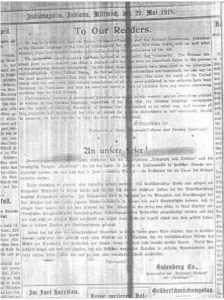
One wonders about the wording “possible disturbance in our community”, were vigilante groups threatening to become active in Indianapolis? In any event, given the anti-German propaganda that the American public was completely marinated in by this time, it would seem a hopeless task for any German language paper published in the United States to stay in business. Perhaps an advertisement that appeared in the May 31, 1918 issue of the Indianapolis Star best captures the feeling of the times. The advertisement is encouraging young men who possess high physical and mental qualifications to join the army tank corps whose motto is “Kill Germans – kill them early, late and all the time but kill them sure.”
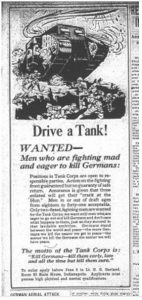
Indiana State Library Receives National Grant to Digitize Historic Indiana Newspapers
The National Endowment for the Humanities (NEH) has awarded a $293,157 grant to the Indiana State Library to digitize Indiana’s historically significant newspapers. Indiana joins 25 states participating in the National Digital Newspaper Program (NDNP), a partnership between the NEH, the Library of Congress and participating states to provide enhanced access to American newspapers published between 1836 and 1922. Newspapers digitized as part of this two-year project will be included in the Library of Congress’ Chronicling America Database (http://chroniclingamerica.loc.gov/).
“This grant is crucial to the State’s efforts to provide optimal public access to Indiana’s historical documents and cultural heritage,” said Jim Corridan, State Archivist and Associate Director of the Indiana State Library. “The State Library houses millions of copies of historic Hoosier newspapers and this initiative will enable Hoosiers instant access to these collections via the internet.”
The Indiana State Library will be assisted on the project by an advisory group of representatives from the Indiana Commission on Public Library, the Indiana Historical Bureau, Ball State University, the Hoosier Press Foundation, the Indiana Historical Society, the Indiana University School of Journalism and Indiana University Purdue University Indianapolis. The advisory group will develop criteria for inclusion of historic papers and ultimately select the newspapers to be digitized.
In addition to the Indiana papers presence in the Chronicling America Database, the digitized papers will also be available through Indiana Memory (http://www.indianamemory.org/) – a collaborative effort to provide access to the wealth of primary sources in Indiana libraries, archives, museums, and other cultural institutions. Indiana Memory’s mission is to create and maintain a digital library that enables free public access to Indiana’s unique cultural and historical heritage. Through information and pictures found in digitized books, manuscripts, photographs, newspapers, maps, and other digital materials available on the Indiana Memory website, the program seeks to enhance education and scholarship of Indiana’s past. As a portal to the collections, Indiana Memory assists individuals to locate materials relevant to their interests and to better appreciate the connections between those materials.
